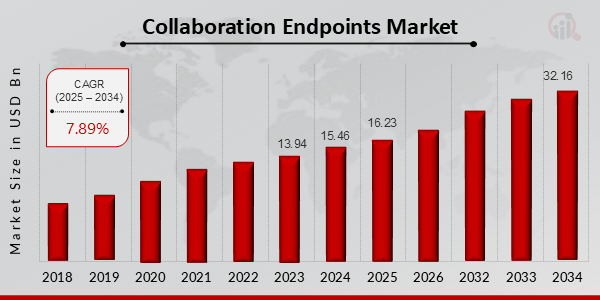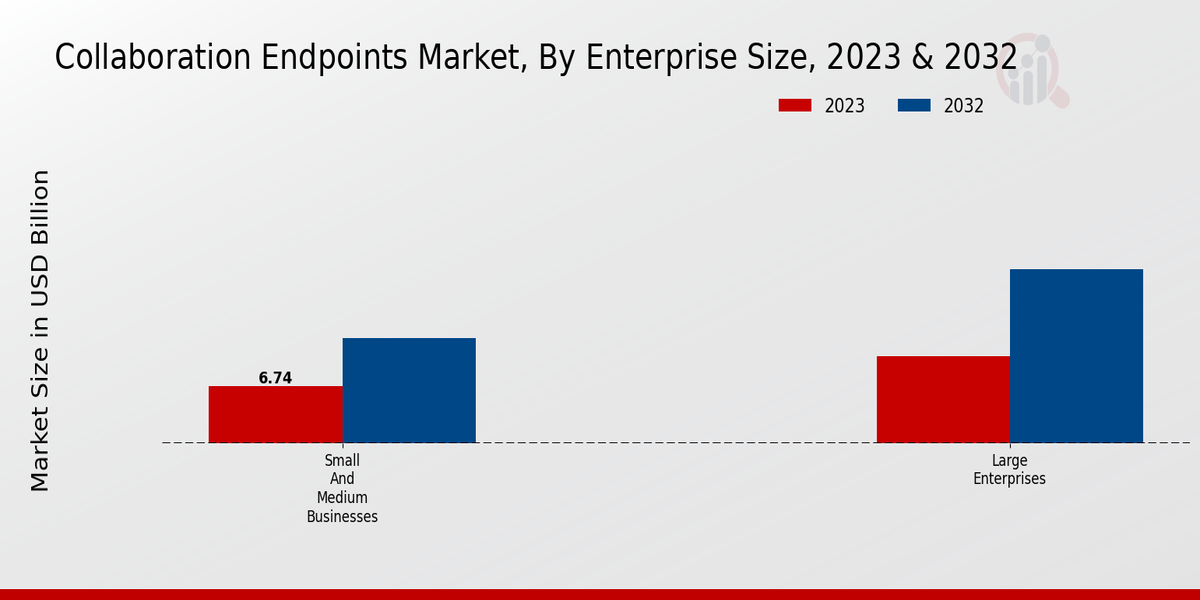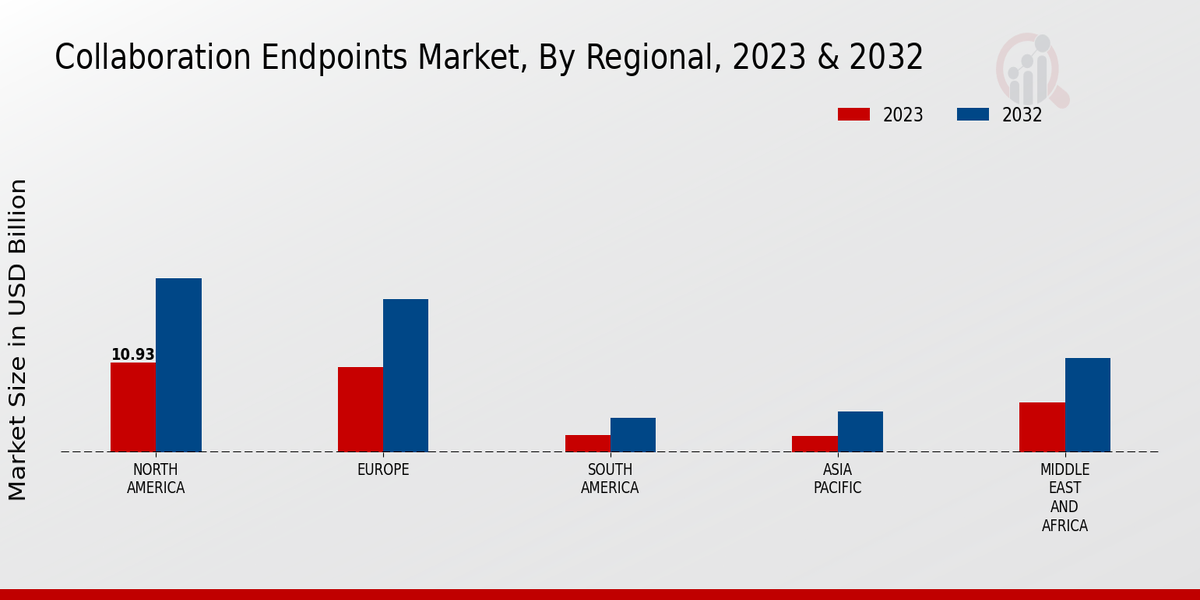Collaboration Endpoints Market Overview
Collaboration Endpoints Market is projected to grow from USD 16.23 Billion in 2025 to USD 32.16 Billion by 2034, exhibiting a compound annual growth rate (CAGR) of 7.89% during the forecast period (2025 - 2034). Additionally, the market size for Collaboration Endpoints Market was valued at USD 15.46 billion in 2024.
Key Collaboration Endpoints Market Trends Highlighted
Key Market Drivers:
The global collaboration endpoints market is driven by several key factors, including the increasing adoption of remote work and hybrid work models, the growing need for effective collaboration tools and the proliferation of cloud-based communication platforms. The rise of artificial intelligence (AI) and machine learning (ML) is also enhancing the capabilities of collaboration endpoints, enabling features such as real-time translation, noise cancellation and virtual backgrounds.
Opportunities to be Explored or Captured:
Emerging trends in the collaboration endpoints market present opportunities for market participants. The growing demand for immersive and interactive experiences is driving the adoption of virtual reality (VR) and augmented reality (AR) technologies in collaboration spaces. Additionally, the integration of collaboration endpoints with other business applications, such as customer relationship management (CRM) and project management tools, is creating new possibilities for seamless collaboration across different workflows.
Recent Trends:
The collaboration endpoints market has witnessed notable trends in recent times. The shift towards software-defined endpoints, which offer greater flexibility and customization, is gaining traction. Additionally, the emergence of Bring Your Own Device (BYOD) policies is driving the adoption of endpoints that are compatible with personal devices. The rising popularity of huddle spaces and small meeting rooms is also creating a demand for compact and affordable collaboration endpoints.
Figure 1: Collaboration Endpoints Market size 2025-2034 
Source: Primary Research, Secondary Research, Market Research Future Database and Analyst Review
Collaboration Endpoints Market Drivers
Remote Workforce Adoption
The increasing adoption of remote work has significantly fueled the demand for collaboration endpoint solutions. Remote workers require reliable and efficient ways to communicate and collaborate with colleagues, clients and partners, regardless of their location. Collaboration endpoints provide a seamless and cost-effective solution by enabling remote teams to participate in virtual meetings, share screens and collaborate on documents in real time.As the remote work trend continues to gain traction, the demand for collaboration endpoints is expected to grow exponentially, driving the overall market growth.
Moreover, the rise of hybrid work models, where employees split their time between the office and remote locations, further underscores the need for robust collaboration endpoints to facilitate seamless communication and collaboration across diverse work environments.
Technological Advancements
Recent years have seen significant advancement of collaboration endpoints from both technological and functional perspectives. First and foremost, the integration of state-of-the-art technologies such as AI, ML and cloud computing has made it possible to upgrade the quality and functionality of collaboration endpoints.
To name a few, users now have at their disposal highly efficient endpoints that offer a superior level of audio and video quality, the real-time translation of speech, noise cancellation and better security features, among other benefits.Furthermore, these IT advancements have also contributed to the reduction of the cost of ownership of endpoints, which expands possibilities for numerous companies.
Growing Need for Enterprise Collaboration
The Global Collaboration Endpoints Market Industry is growing as enterprises look for such solutions to ensure better communication among the staff to affect the success of the firm or organization. Collaboration endpoints ensure smooth collaboration between the working staff in different departments or branches and other stakeholders such as the clients. This ensures that there is no communication barrier between the different parties by making the workstation one centralized place for meetings, file sharing, chatting and other activities.In the end, the workflow processes are made simple, which morseo boosts production and innovativeness.
Collaboration Endpoints Market Segment Insights
Collaboration Endpoints Market Enterprise Size Insights
The Global Collaboration Endpoints Market is segmented based on enterprise size into small and medium businesses (SMBs) and large enterprises. Small and Medium Businesses (SMBs) dominate the Global Collaboration Endpoints Market, accounting for over 60% of the market share. This dominance is attributed to the increasing adoption of collaboration tools by SMBs to improve communication, collaboration and productivity. The growing number of remote workers and the need for cost-effective communication solutions are further driving the growth of the SMB segment.
On the other hand, large enterprises are expected to witness a higher growth rate during the forecast period due to their increasing investments in collaboration technologies to enhance employee productivity, streamline business processes and improve customer engagement. Large organizations are also adopting advanced collaboration tools such as video conferencing, unified communications and collaboration platforms to facilitate seamless communication and collaboration among their distributed workforce. The increasing adoption of cloud-based collaboration solutions and the growing popularity of bring-your-own-device (BYOD) policies are further contributing to the growth of the collaboration endpoints market in both SMBs and large enterprises.

Source: Primary Research, Secondary Research, Market Research Future Database and Analyst Review
Collaboration Endpoints Market Deployment Model Insights
The Global Collaboration Endpoints Market Segmentation by Deployment Model is categorized into On-Premises, Cloud-Based and Hybrid. The Cloud-Based segment held the largest market share in 2023, accounting for over 55% of the Global Collaboration Endpoints Market revenue. This dominance is attributed to the growing adoption of cloud-based solutions, which offer benefits such as scalability, flexibility, and cost-effectiveness. The Hybrid segment is projected to witness the fastest growth over the forecast period, owing to the increasing need for organizations to integrate on-premises and cloud-based solutions for a comprehensive collaboration experience.
The On-Premises segment is expected to maintain a steady growth rate, as some organizations continue to prefer on-premises deployments for security and control reasons.
Collaboration Endpoints Market Application Insights
The Global Collaboration Endpoints Market is segmented by Application into Unified Communications and Collaboration (UCC), Video Conferencing, Instant Messaging and Team Collaboration, Device Management and Control, Analytics and Reporting. The UCC segment is expected to hold the largest market share in 2023, owing to the growing adoption of cloud-based UCC solutions and the increasing need for real-time collaboration. The Video Conferencing segment is expected to witness significant growth over the forecast period, driven by the rising demand for remote collaboration and video-enabled meetings.
The Instant Messaging and Team Collaboration segment is also expected to grow steadily as businesses increasingly adopt messaging and collaboration platforms for internal communication and project management. The Device Management and Control segment is expected to play a crucial role in managing and securing collaboration endpoints, while the Analytics and Reporting segment is expected to provide valuable insights into collaboration usage and trends. Overall, the Global Collaboration Endpoints Market is expected to grow significantly over the forecast period, driven by the increasing adoption of collaboration technologies and the growing need for flexible and efficient communication solutions.
Collaboration Endpoints Market Device Type Insights
The Global Collaboration Endpoints Market is segmented by Device Type into Desktop Endpoints, Room Systems, Mobile Endpoints, Wearable Devices and Peripherals (e.g., cameras, microphones). Among these segments, Desktop Endpoints held the largest market share in 2023, accounting for around 45% of the Global Collaboration Endpoints Market revenue. Room Systems, with their advanced audio and video capabilities, are expected to witness the fastest growth over the forecast period, reaching a market size of USD 4.2 billion by 2032. Mobile Endpoints, including smartphones and tablets, are gaining traction due to the increasing adoption of remote and hybrid work models.
Wearable Devices and Peripherals are expected to play a niche role in the market, with Peripherals witnessing significant growth due to the need for enhanced collaboration experiences.
Collaboration Endpoints Market Vertical Insights
The Global Collaboration Endpoints Market segmentation by Vertical can be divided into Finance and Banking, Healthcare, Education, Government, IT and Telecom and Manufacturing. The Finance and Banking sector is expected to dominate the market due to the increasing adoption of collaboration tools to enhance communication and collaboration among employees and customers. The Healthcare sector is also expected to witness significant growth due to the rising demand for telemedicine and remote patient monitoring solutions. The Education sector is expected to grow steadily due to the increasing adoption of online learning and distance education platforms.
The Government sector is expected to invest in collaboration endpoints to improve communication and collaboration among government agencies and departments. The IT and Telecom sector is expected to witness moderate growth due to the increasing demand for collaboration tools for remote working and customer support. The Manufacturing sector is expected to grow slowly due to the adoption of collaboration tools to improve communication and collaboration among employees and partners.
Collaboration Endpoints Market Regional Insights
The Global Collaboration Endpoints Market is segmented into North America, Europe, APAC, South America and MEA. North America is the largest market for collaboration endpoints, accounting for over 35% of the global market revenue in 2023. The region is expected to continue to dominate the market in the coming years, driven by the increasing adoption of cloud-based collaboration solutions and the growing demand for video conferencing and unified communications solutions. Europe is the second-largest market for collaboration endpoints, followed by APAC.
The APAC region is expected to witness the fastest growth in the coming years due to the increasing adoption of collaboration endpoints in emerging economies such as China and India. South America and MEA are relatively smaller markets for collaboration endpoints, but they are expected to grow at a steady pace in the coming years.

Source: Primary Research, Secondary Research, Market Research Future Database and Analyst Review
Collaboration Endpoints Market Key Players And Competitive Insights
Major players in Collaboration Endpoints Market are investing heavily in research and development to gain a competitive edge. They are also expanding their product portfolios to cater to the diverse needs of customers. Collaboration Endpoints Market industry is highly competitive, with a number of leading players vying for market share. Some of the key competitive strategies adopted by players include product innovation, strategic partnerships, and acquisitions. Leading Collaboration Endpoints Market players are also focusing on expanding their global footprint through strategic partnerships and acquisitions.
The Collaboration Endpoints Market is expected to witness significant growth in the coming years, driven by the increasing adoption of collaboration technologies and the growing need for remote collaboration. Collaboration Endpoints Market development is also being driven by the increasing adoption of cloud-based collaboration solutions.
Cisco Systems is a leading provider of collaboration endpoints. The company offers a wide range of collaboration endpoints, including video conferencing systems, audio conferencing systems, and web conferencing systems. Cisco Systems has a strong presence in the Collaboration Endpoints Market industry, with a large customer base and a well-established brand. The company is also investing heavily in research and development to develop new and innovative collaboration endpoints. Poly is a leading provider of collaboration endpoints. The company offers a wide range of collaboration endpoints, including video conferencing systems, audio conferencing systems, and web conferencing systems.
Poly has a strong presence in the Collaboration Endpoints Market industry, with a large customer base and a well-established brand. The company is also investing heavily in research and development to develop new and innovative collaboration endpoints.
Microsoft is a leading provider of collaboration endpoints. The company offers a wide range of collaboration endpoints, including video conferencing systems, audio conferencing systems, and web conferencing systems. Microsoft has a strong presence in the Collaboration Endpoints Market industry, with a large customer base and a well-established brand. The company is also investing heavily in research and development to develop new and innovative collaboration endpoints. Logitech is a leading provider of collaboration endpoints. The company offers a wide range of collaboration endpoints, including video conferencing systems, audio conferencing systems, and web conferencing systems.
Logitech has a strong presence in the Collaboration Endpoints Market industry, with a large customer base and a well-established brand. The company is also investing heavily in research and development to develop new and innovative collaboration endpoints.
Key Companies in the Collaboration Endpoints Market Include
Collaboration Endpoints Market Industry Developments
The global Collaboration Endpoints Market size was valued at USD 12.93 billion in 2023 and is projected to grow at a CAGR of 7.89% to reach USD 25.6 billion by 2032. The growth of the market is attributed to the increasing adoption of remote work and hybrid work models, the need for improved collaboration and communication, and the growing popularity of cloud-based collaboration solutions.
Recent news developments in the market include the launch of new products and services by major vendors such as Cisco, Microsoft and Zoom. For instance, in 2023, Cisco introduced the Cisco Webex Room Navigator, a touch-screen device that simplifies meeting control and collaboration. Additionally, Microsoft announced the integration of its Teams collaboration platform with the Surface Hub 2S, providing users with a seamless experience for video conferencing and collaboration.
Major players in the market are focusing on strategic partnerships and acquisitions to expand their product offerings and geographical reach. For example, in 2023, Zoom acquired the cloud-based video platform Kites to enhance its video conferencing capabilities. Furthermore, vendors are investing in research and development to develop innovative solutions that meet the evolving needs of businesses.
Collaboration Endpoints Market Segmentation Insights
-
Collaboration Endpoints Market Enterprise Size Outlook
-
Collaboration Endpoints Market Deployment Model Outlook
-
Collaboration Endpoints Market Application Outlook
-
Collaboration Endpoints Market Device Type Outlook
-
Collaboration Endpoints Market Vertical Outlook
-
Collaboration Endpoints Market Regional Outlook
|
Report Attribute/Metric
|
Details
|
|
Market Size 2024
|
15.46 (USD Billion)
|
|
Market Size 2025
|
16.23 (USD Billion)
|
|
Market Size 2034
|
32.16 (USD Billion)
|
|
Compound Annual Growth Rate (CAGR)
|
7.89% (2025 - 2034)
|
|
Report Coverage
|
Revenue Forecast, Competitive Landscape, Growth Factors, and Trends
|
|
Base Year
|
2024
|
|
Market Forecast Period
|
2025 - 2034
|
|
Historical Data
|
2019 - 2023
|
|
Market Forecast Units
|
USD Billion
|
| Key Companies Profiled |
NEC, Logitech, Crestron, Microsoft, Samsung, Huawei, Yealink, Cisco, Alcatel-Lucent Enterprise, Google, Poly, Avaya, Konftel, Barco, Zoom |
| Segments Covered |
Enterprise Size, Deployment Model, Application, Device Type, Vertical, Regional |
| Key Market Opportunities |
Growing demand for remote collaboration Digital transformation initiatives Cloud-based solutions AI-powered features Increasing adoption in healthcare and education |
| Key Market Dynamics |
Increased remote work Cloud-based solutions AI-enabled features Integration with productivity tools Demand for immersive experiences |
| Countries Covered |
North America, Europe, APAC, South America, MEA |
Frequently Asked Questions (FAQ):
The Global Collaboration Endpoints Market was estimated to be valued at USD 12.93 billion in 2023.
The Global Collaboration Endpoints Market is projected to grow at a CAGR of 7.89% from 2025 to 2034
North America is expected to hold the largest market share in the Global Collaboration Endpoints Market in 2023.
Key applications of Collaboration Endpoints include video conferencing, web conferencing, and instant messaging.
Major key competitors in the Global Collaboration Endpoints Market include Cisco, Microsoft and Zoom.
Factors driving the growth of the Global Collaboration Endpoints Market include the increasing adoption of remote work and the growing need for collaboration tools.
Challenges faced by the Global Collaboration Endpoints Market include security concerns and the need for interoperability between different platforms.
Opportunities for growth in the Global Collaboration Endpoints Market include the development of new technologies and the expansion into new markets.
Trends in the Global Collaboration Endpoints Market include the increasing use of artificial intelligence and the adoption of cloud-based solutions.
The Global Collaboration Endpoints Market is expected to reach USD 32.16 billion by 2034

















